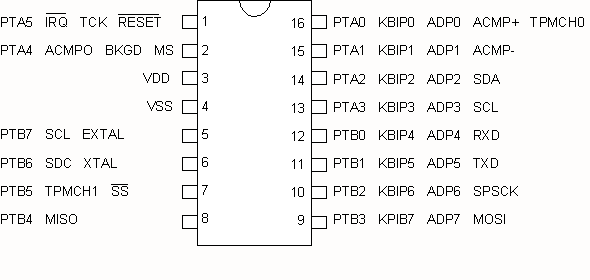
|
|
|
Freescale
MC9S08QG8/4
|
|
|
Code
Example #3
|
| 2011.12.31 | ||
| 2012.01.01 | - recent update | |
| - added LCD info | ||
| - added Example 4. | ||
| 2012.01.13 | - Introduction to Examples | |
| - added explanations, various comments | ||
| - added example 5 | ||
| 2012.01.15 | - Global and local variables | |
| - Stacks | ||
| 2012.01.16 | - Interrupts | |
| 2012.01.19 | - 7-Segment LED interface | |
| 2012.02.13 | - Example #10 - Four 7-segment LED multiplexed | |
| 2012.02.14 | - Modifications to Example #10 | |
| 2012.03.14 | - Examples on individual pages | |
| Example #1 | Simple ASM program vs C program | |
| Watchdog Memory I/O Model Page Zero Addressing Infinite Loop External Crystal |
||
| Example #2 | Flashing LED |
|
| Software delay | ||
| Example #3 | Character Output | |
| Serial Transmit Data LCD Display Function Prototypes |
||
| Example #4 | Text Message | |
| Characters, Strings and Pointers |
||
| Example #5 | Timer test with oscilloscope |
|
| Example #6 | Timer test with flashing LED | |
| Gobal and Local variables Stacks Subroutines |
||
| Example #7 | Timer test with flashing LED using interrupts | |
| Interrupts | ||
| Example #8 | Single Hexadecimal Display on 7-segment LED | |
| Common Cathode Display | ||
| Example #9 | Single Hexadecimal Display on 7-segment LED | |
| Common Anode Display | ||
| Example #10 | Four multiplexed 7-segment Common Anode LED | |
| Displaying decimal digits Switch/Case statements |
||
| Example #11 | Four multiplexed 7-segment Common Anode LED | |
| Displaying 8-bit and 16-bit integers as hexadecimal digits | ||
The purpose of this example is to output the letter 'A' once a second on the LCD display. Data is transmitted in the coded ASCII representation to the serial port at 9600 bits per second. The LEDs will continue to flash as in the previous example.
Skip this example if you have no means of displaying ASCII text sent via a
TTL or RS-232 channel.
#include <MC9S08QG8.h>
// Declare function protoypes here.
void Delay(unsigned long delay);
void putc(char ch);
void main(void)
{
SOPT1 = 0x52; // disable COP watchdog
PTBDD = 0b00111111; // // set
PTB0-5 as output
// select external xtal
ICSC1 = 0b10000000;
ICSC2 = 0b00110110;
// initialise SCI for serial output
SCIBDH = 0;
SCIBDL = 26;
SCIC2 = 0x0C;
for(;;)
{
putc('A');
PTBD = 0b00111111; // pulse PTB0-5 high
Delay(6000);
PTBD = 0;
Delay(6000);
}
}
void Delay(unsigned long delay)
{
unsigned long i;
for (i=0; i<= delay;i++)
{
}
}
void putc(char ch)
// output one ASCII char to SCI TD (pin 11)
{
while (SCIS1_TDRE == 0);
SCID = ch;
}
Before sending data on the SCI (Serial Communications Interface, another term
for UART), the transmitter flag must be checked to see if the transmitter is
ready to accept new data. We have to wait for TDRE (Transmit Data Register Empty)
to be 1 before writing the new data to the SCI Data register. The while(
) statement shown will loop back to itself as long as the TDRE bit is
0. Note that this is an optimizing compiler and it will select the most efficient
asm code for this instruction. Disassemble the C code and learn how this is
translated into asm code.
while (SCIS1_TDRE == 0);
SCID = ch;
- added 2012.01.01
The 2x16 LCD character display is a popular display using the commonly used Hitachi HD44780 Controller/Driver chip. The controller is designed to be used for 80-character displays in many popular configurations, for example, 1x16, 2x16, 2x20, 2x40, 4x16, 4x20.
The 2x16 display format actually uses the 2x40 format. Hence the first 16 characters will appear on the first line. The next 24 characters will not be visible. The second 40 characters will be assigned to the second line, only the first 16 characters being visible.
More information on interfacing directly to the LCD module will be provided at a later date.
What is a function prototype? Compilers can be designed as either a single-pass or muliple-pass compiler. In a single-pass compiler, the compiler needs to scan the program code only once and all variables and function calls can be resolved. In order to accomplish this, the program must provide information such as type of variable or function ahead of usage. In a multiple-pass compiler, the compiler can resolve unknown variables and usage on subsequent scans through the program code.
In a single-pass compiler, the program must declare the type of variables and the format of functions, i.e. how many parameters are passed to the function and what results are returned. This is the function prototype. The prototype is the same format as the header of the function and must end with a semi-colon. The void statement indicates that no parameter is passed. Note that the variable names are dummy names and are not important.
//Variable Declarations
char my_char;
char[20] my_message;
unsigned int counter, number;
byte hi_byte, lo_byte;
byte[40] my_data;
// Function Protoypes
void MyInit(void);
void Delay(unsigned long d);
void putc(char ch);
void message(char *string);
char getc(unsigned int COM);
double square_root(double x);

Connect Vss to GND
2006.11.09 - 2012.03.14